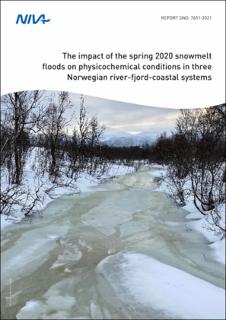| dc.contributor.author | Poste, Amanda | |
| dc.contributor.author | Kaste, Øyvind | |
| dc.contributor.author | Frigstad, Helene | |
| dc.contributor.author | de Wit, Heleen | |
| dc.contributor.author | Harvey, Therese | |
| dc.contributor.author | Valestrand, Louise | |
| dc.contributor.author | Deininger, Anne | |
| dc.contributor.author | Bryntesen, Tina | |
| dc.contributor.author | Delpech, Lisa-Marie | |
| dc.contributor.author | Christensen, Guttorm | |
| dc.date.accessioned | 2021-11-16T11:39:37Z | |
| dc.date.available | 2021-11-16T11:39:37Z | |
| dc.date.created | 2021-11-16T11:28:18Z | |
| dc.date.issued | 2021 | |
| dc.identifier.isbn | 978-82-577-7387-8 | |
| dc.identifier.issn | 1894-7948 | |
| dc.identifier.uri | https://hdl.handle.net/11250/2829822 | |
| dc.description | Project Manager Heleen de Wit | en_US |
| dc.description.abstract | Due to very high snow accumulation in the winter of 2019/2020, the Norwegian Water Resources and Energy Directorate (NVE) in late May 2020 issued flood forecasts predicting extremely high flood risk for parts of northern Norway and high flood risk for rivers in south-eastern Norway with mountainous catchments. To capture impacts of these potentially extreme snowmelt floods on water chemistry in rivers and coastal waters, extra sampling campaigns were carried out in three selected river-fjord systems: Glomma river-Ytre Oslofjord-Skagerrak in southern Norway, and the Målselv river-Målselvfjord-Straumsfjorden and Tana river-Tanafjord systems in northern Norway. The overarching goal was to study the impact of the 2020 spring freshet (i.e. snowmelt flood) on river water chemistry, land-ocean fluxes, and physicochemical conditions in coastal waters. In this report we describe between-site differences and seasonal patterns in river and coastal water chemistry based on existing data from national river (2016–2020) and coastal (2017–2020) monitoring in the three study regions, and then use these to provide context for the data from the spring 2020-sampling campaign, with a focus on suspended particulate matter (SPM), dissolved organic carbon (DOC), and nutrients. This report also highlights the complexity of identifying climate change impacts along the terrestrial-freshwater-marine continuum and the need for tighter cross-disciplinary and cross-ecosystem integration between monitoring programmes. | en_US |
| dc.language.iso | eng | en_US |
| dc.publisher | Norsk institutt for vannforskning | en_US |
| dc.relation.ispartof | NIVA-rapport | |
| dc.relation.ispartofseries | NIVA-rapport;7651 | |
| dc.relation.ispartofseries | Miljødirektoratet-rapport;M-2079 | |
| dc.subject | Elver | en_US |
| dc.subject | Rivers | en_US |
| dc.subject | Marint og kystvann | en_US |
| dc.subject | Marine and coastal water | en_US |
| dc.subject | Vårflom | en_US |
| dc.subject | Spring freshet | en_US |
| dc.subject | Vannkvalitet | en_US |
| dc.subject | Water quality | en_US |
| dc.title | The impact of the spring 2020 snowmelt floods on physicochemical conditions in three Norwegian river-fjord-coastal systems | en_US |
| dc.type | Research report | en_US |
| dc.description.version | publishedVersion | en_US |
| dc.rights.holder | © Norwegian Institute for Water Research and the Norwegian Environment Agency. The publication can be cited freely if the source is stated. | en_US |
| dc.subject.nsi | VDP::Matematikk og naturvitenskap: 400 | en_US |
| dc.subject.nsi | VDP::Mathematics and natural scienses: 400 | en_US |
| dc.source.pagenumber | 45 | en_US |
| dc.source.issue | 7651 | en_US |
| dc.identifier.cristin | 1955071 | |
| cristin.ispublished | true | |
| cristin.fulltext | original | |
